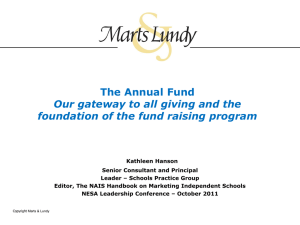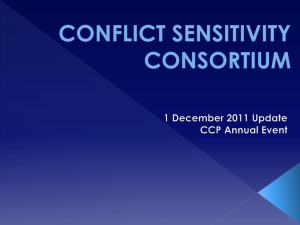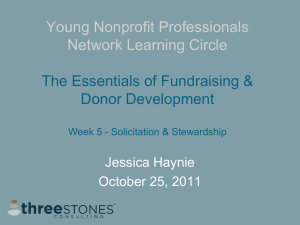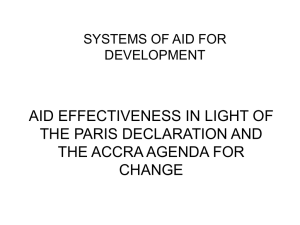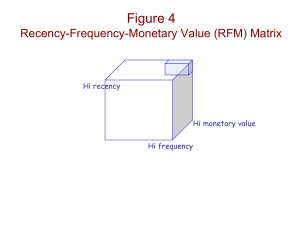Analytics for Annual Fund Segmentation: 2012
advertisement
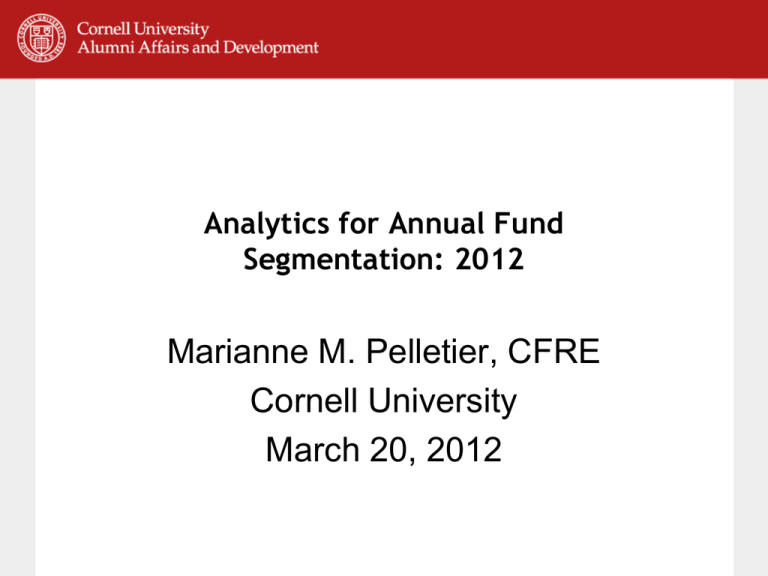
Analytics for Annual Fund Segmentation: 2012 Marianne M. Pelletier, CFRE Cornell University March 20, 2012 Outline • RFM (Recency, Frequency, and Monetary Value), • ROI (Return on Investment) • Understanding engagement Wisdom from Kevin MacDonnell • “Sometimes I employ a practice in our Phonathon program simply because my gut says it’s gotta work. “ • See: http://cooldata.wordpress.com/2011/10/03/ data-1-gut-instinct-0/ Easy to measure, fun to use RFM What Is RFM For? • Uses 3 measures instead of 1 to segment donors. • Builds a color chart of very top donors. • Builds a color chart of top donors in categories. • Considers volume and time as well as value. • Helps define methods that work. RFM – A Powerful Segmentation Tool 40% $150 $160 $139 35% $140 Response Rate 30% Response Rate •Frequency is predictive of both response rate and average gift size, but is not as strong a predictor as recency. Recency $120 Average Gift Size 25% $100 20% $80 15% $60 $49 10% $40 $11 •Monetary is defined (in this example) as the average of giving over the prior five years and is the best predictor of average gift size, but less predictive of response rate. 5% $20 $11 0% $0 within 6 months 6-18 mos 18-36 mos 3-4 years 4-5 years Borrowed from Sally Boucher of WealthEngine, See: http://www.wealthengine.com/newsevents/educational-webinars/fundraisingintelligence-actionable-strategies-growing-your-0 Average Gift Size •Recency is the best predictor of response rate, indicated by the greatest separation between highest and lowest segments. Those who had given within the past six months may have had a lower response rate because they possibly had JUST given. Recency • How recently did the donor give? • Can you go back again for another gift? • Helps show LYBUNTS and SYBUNTS Frequency • Monthly or annual pledge payments? • Givers every year • Finds infrequent but high donors (5-year pledgers) Monetary Value Obvious! Data Prep Considerations • If you are measuring annual giving year by year, use one year’s worth of giving information. • If you are measuring annual giving trends, use 3 or 5 years. • If you are measuring lifetime value, use all giving. How to score your file for RFM: 5Year Giving Example 1. Rank all constituents by Recency (limit to five years of giving history). 2. Divide the total by 5 – this will give you the number of records to score in each “quintile” or 5th of the file 3. Assign the top 5th – those who have given most recently - the number “5” 4. Continue assigning each 5th of the file a number until you get to the final 5th with the most distant gift date and assign these the number “1” 5. Repeat these steps by ranking all records for Frequency (number of gifts in a 5 year period – excluding pledge payments, monthly credit card payments and other anomalies) 6. Repeat these steps for Monetary represented by the total giving (again, over a five-year period). This and the next 3 slides are also borrowed from Sally Boucher of WealthEngine. See: http://www.wealthengine.com/news-events/educational-webinars/fundraising-intelligence-actionablestrategies-growing-your-0 Three-Year RFM Analysis Example: Prep 3-Year RFM Sample Values Row Labels Max of GIFT_DATE_SQL Count of GIFT_NO Sum of GIFT_AMOUNT 1000057 4/11/2011 4 $70.00 1000058 2/2/2012 4 $155.00 1000061 6/8/2010 3 $1,550.00 1000067 9/29/2010 2 $120.00 1000069 6/28/2011 4 $3,000.00 1000076 11/29/2011 7 $750.00 Top 4th 3rd 2nd Bottom =PERCENTILE(B5:B94361,0.8) =PERCENTILE(B6:B94362,0.6) =PERCENTILE(B7:B94363,0.4) =PERCENTILE(B8:B94364,0.2) Below 2nd Top 4th 3rd 2nd Bottom =PERCENTILE(C5:C94361,0.8) =PERCENTILE(C6:C94362,0.6) =PERCENTILE(C7:C94363,0.4) =PERCENTILE(C8:C94364,0.2) Below 2nd 11/25/2011 5/27/2011 11/30/2010 12/3/2009 Below 2nd =PERCENTILE(D5:D94361,0.8) =PERCENTILE(D6:D94362,0.6) =PERCENTILE(D7:D94363,0.4) =PERCENTILE(D8:D94364,0.2) Below 2nd 4.00 2.00 1.00 1.00 Below 2nd 1000.00 300.00 100.00 50.00 Below 2nd Three-Year RFM Analysis Example: Prep Marking each record by its bin =IF(B4>=DATEVALUE("11/25/2011"),5,I F(B4>=DATEVALUE("5/27/2011"),4,IF( B4>=DATEVALUE("11/30/2010"),3,IF(B 4>=DATEVALUE("12/3/2009"),2,1)))) For frequency, bin 1,2 and 3 had the same starting value: 1, so all below a value of “2” are scored at the third bin. =IF(C2>=4,5,IF(C2>=2,4,IF(C2>=1,3,1))) For monetary, we also marked the records by the indicated bins. =IF(D2>=1000,5,IF(D2>=300,4,IF(D2>=10 0,3,IF(D2>=50,2,1)))) Recency 5 4 How it Works Frequency 5 4 3 3 2 2 1 1 Money 5 4 3 2 1 125 Segments 4-3-4 Segment Based on RFM Scoring Best Scorers: Upgrade at low cost and/or refer to major or planned giving departments. Steward thoughtfully. High Money: Find new ways to engage face to face or through personalized events. 5-5-5 5-5-4 5-5-3 5-5-2 5-5-1 5-4-1 5-4-2 5-3-1 5-5-3 5-4-4 5-4-3 5-3-4 5-3-2 4-5-1 4-5-2 4-4-1 4-5-5 4-5-4 4-4-5 4-4-4 4-5-2 3-5-1 3-5-2 3-3-1 3-3-5 3-3-4 3-2-5 3-2-4 3-3-3 3-2-2 3-2-3 3-2-1 3-1-5 3-1-4 2-4-5 2-4-4 2-3-1 2-4-1 2-4-2 2-4-3 2-3-5 2-3-4 2-2-5 2-2-4 2-3-3 2-3-2 2-2-2 2-2-1 Frequent Givers: Upgrade or renew at low cost. Middles: Increase frequency with monthly gift club? Reengage lapsed donors with targeted appeal. Our 3-Year Sample Based on RFM Putting the score together, use the ampersand: =E4&F4&G4. Pivot on the score. Our 3-Year Sample Not a whole lot of high frequency, high recency, low monetary scorers, which is good. Monetary Score = 5 Recency Frequency 3 1 2 3 4 5 Count Recency Frequency 4 Frequency 5 All 1495 494 71 1038 1190 371 599 1891 1208 586 1428 3272 368 1415 5633 4086 6418 10555 2060 2599 3698 5286 7416 21059 Frequency 3 Frequency 4 Frequency 5 Average All 1 $25,644.54 $51,586.55 $2,736,593.76 $125,301.22 2 $31,090.32 $30,545.21 $107,953.84 $41,812.79 3 $25,553.28 $47,991.13 $131,177.77 $71,530.66 4 $30,420.92 $38,603.52 $85,583.49 $66,776.71 5 $24,443.90 $18,305.88 $138,017.21 $109,540.06 Overall Average $27,591.48 $36,399.57 $137,403.30 $85,314.74 Alternative Data Preparation • Use 3 segments instead of 5 if your results are too granular. • Use CHAID for finding the segment boundaries. Alternative Frequency/Recency • Last gift date is recency • Count of gifts (lifetime or time that you measure) is frequency • Or count of payments in one year if you are measuring only one year Example: Small Alumni Base – Smaller Number of Bins Using CHAID for Determining Segments Highest possible score is 6-7-5 7 bins for freq. 6 bins for recency CHAID Results: Frequency • The more often they give, the higher the money • Frequency of 1 or 2: date matters CHAID Results: Recency This result is not as linear. Different Ways to Look at Results ROI: RETURN ON INVESTMENT Cost Per Dollar Raised: Renewals Recognition Level Donors Resource Cost Per #Attempts #Reached Total Gifts Total Cost Cost Per $1 Letter $0.03 490 490 $35,855.45 $14.70 $0.0004 Envelope $0.03 490 490 $35,856.45 $14.70 $0.0004 Postage $0.25 490 490 $35,857.45 $122.50 $0.0034 BRE $0.04 490 490 $35,858.45 $19.60 $0.0005 BRE Postage $0.44 490 189 $35,859.45 $83.16 $0.0023 Total Cost Per Dollar Raised: $0.0071 LYBUNTS, SYBUNTS Data is from 1999. Resource Cost Per #Attempts #Reached Total Gifts Total Cost Cost Per $1 Letter $0.03 7551 7551 $51,484.65 $226.53 $0.0044 Envelope $0.03 7551 7551 $51,484.65 $226.53 $0.0044 Postage $0.25 7551 7551 $51,484.65 $1,887.75 $0.0367 BRE $0.04 7551 7551 $51,484.65 $302.04 $0.0059 BRE Postage $0.44 7551 452 $51,484.65 $198.88 $0.0039 Phone Call $0.53 7551 4384 $51,484.65 $2,323.52 $0.0451 Caller Pay $1.74 7551 4384 $51,484.65 $7,628.16 $0.1482 Reminder Envelope $0.03 7551 1805 $51,484.65 $54.15 $0.0011 Reminder Postage $0.25 7551 1805 $51,484.65 $451.25 $0.0088 Reminder BRE $0.09 7551 1805 $51,484.65 $162.45 $0.0032 Reminder BRE Postage $0.44 7551 486 $51,484.65 $213.84 $0.0042 Total Cost Per Dollar Raised: $0.2656 Cost Per Dollar Raised: New Donors Resource Cost Per #Attempts #Reached Total Gifts Total Cost Cost Per $1 Letter $0.03 7731 7731 $8,530.20 $231.93 $0.0272 Envelope $0.03 7731 7731 $8,530.20 $231.93 $0.0272 Postage $0.25 7731 7731 $8,530.20 $1,932.75 $0.2266 BRE $0.04 7731 7731 $8,530.20 $309.24 $0.0363 BRE Postage $0.44 7731 16 $8,530.20 $7.04 $0.0008 Phone Call $0.53 7731 3700 $8,530.20 $1,961.00 $0.2299 Caller Pay $1.74 7731 3700 $8,530.20 $6,438.00 $0.7547 Reminder Envelope $0.03 7731 686 $8,530.20 $20.58 $0.0024 Reminder Postage $0.25 7731 686 $8,530.20 $171.50 $0.0201 Reminder BRE $0.09 7731 686 $8,530.20 $61.74 $0.0072 Reminder BRE Postage $0.44 7731 408 $8,530.20 $179.52 $0.0210 Total Cost Per Dollar Raised: $1.3535 Do we stop trying to acquire new donors? Cost Per $1 Raise: Longer Sightedness • • • • 39% of recognition level donors renewed. 12% of LYBUNTS/SYBUNTS renewed. 5% of nondonors became donors. Consider: 12% of new donors renew. Cost Per Dollar Raised: Longer Sightedness LYBUNTS/SYBUNT Pool 2nd Year 7975 LYBUNTS/SYBUNT Renewals 957 Average Gift $54.89 Total Giving $52,527.52 Total Cost (same ratio) $14,442.98 Cost Per Dollar Raised $0.2750 Two-Year Cost Per $1 Raised $0.81 Gifts Per System Hour Description # of IDs in Pool System Time Total $ Match Rate Avg Total Pledge Pledge Rate Credit Card Rate Gifts Per System Hour General NonDonors FY08 (all gen non-donor pools) 27391 720:40:00 $56,218.38 10.65% $117.37 17.99% 41.34% $1,872 FY07 19066 694:07:00 $45,749.19 9.72% $108.41 11.67% 30.81% $1,582 FY06 18409 458:11:04 $56,528.03 14.89% $92.52 17.78% 26.35% $2,961 FY05 24539 $68,381.76 8.84% $85.16 12.60% 19.43% Timeline: When do Most Gifts Come In? 1st phonathon gift Last phonathon gift 8/29 Bulk of phonathon returns phonathon Bulk of mail returns starts 30 9/9/2009 Mailing date 1st mail gift 60 90 120 150 180 What could we have been doing here? 210 240 Last mail gift Timeline: Use the 95% Confidence Interval 95% Confidence Interval and Giving • 95% of gifts come in within 53 days of mailing (e-mail) for this segment. • Count percent of all gifts from this segment who gave within 53 days. • This sample: Gave later than 53 days Gave within 53 days ENGAGEMENT Aren’t We the Engagement Makers? • Annual giving programs are responsible for engaging new donors, donor renewal • Can engagement indicators also be used for annual giving programs? • What would that look like? The Information Score Prospects who tell you more about themselves are more likely to become donors. Variables in the Equation B S.E. Wald df Sig. Exp(B) MSFlag -.203 .038 29.243 1 .000 .816 BirthdateFlag -.135 .039 12.162 1 .000 .874 .885 .040 489.738 1 .000 2.423 3.116 .120 674.705 1 .000 22.549 CountofDegrees .275 .036 59.032 1 .000 1.316 SpecPrefixFlag .626 .081 59.422 1 .000 1.869 -4.897 .134 1330.023 1 .000 .007 EmailFlag CountofConstituency Step 1a Constant a. Variable(s) entered on step 1: MSFlag, BirthdateFlag, EmailFlag, CountofConstituency, CountofDegrees, SpecPrefixFlag. Triggers from Donors for Leadership Givers • First gift amount: What is the average for your top donors? It’s usually higher than for other donors. • Velocity: If a donor gives 2 times this year as the average of her prior 3 years’ giving, pay attention. • UpOrDown: Increasing giving more often than decreasing – steward and ask. Modeling Characteristics of High End Donors 1. Giving to funds outside of annual giving 2. Presence of a special prefix 3. Presence of an email address 4. More than one designation assigned to the prospect’s highest gift 5. First gift amount – cultivate and steward prospects whose first gift amount is $3,500 or more Velocity • Test velocity and reward high velocity donors with higher touch contact. GivingLast Year AverageGiv ing Pr evious 3Years Page 40 Velocity: Pursue Donors with a Velocity of 2.0 or More Score 1 or less Score 1.1 to 2.9 Score 3 or more UpOrDown Score • Measure increase in giving over a prior year as 1. • Measure decrease in giving over a prior year as -1. • Measure repeated giving as 0. • Measure over 5 years’ changes. • Sum the scores. UpOrDown Score: 2 or More Why Am I Not Mentioning Events? • Most organizations have difficulty tracking event attendance. • However, prospects who refuse events tend to be donors more often than those who don’t bother. • Event attendance and survey responses will become important over time. • Social media are virtual events. Social Media: At the Question Stage • Can you track which of your prospects list you on their LinkedIn accounts? • Are you using MeltWater.com to track tweets about you? • Who likes you on Facebook? Donors? Large donors? WRAP UP Where Do I Begin? • What does your program need to do? – Acquire donors – Retain donors – Upgrade donors Pick a Method/Study You Understand • If you’ve never heard of CHAID, learn about it before using it. • Use a study that resonates with you. • Get results, implement the strategy, and measure performance. • After that, learn something new. • Lather, rinse, repeat. Questions? • Marianne: – marianne@helenbrowngroup.com – mmp39@cornell.edu – Twitter: mpellet771

